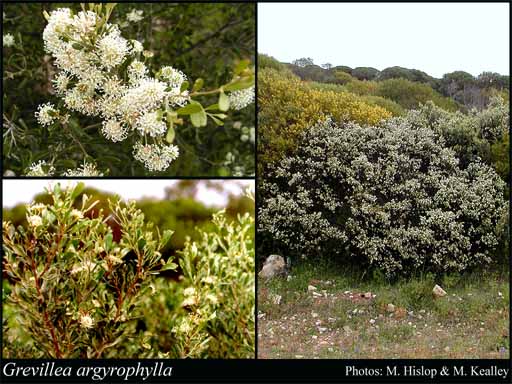- Reference
- Hooker's J.Bot.Kew Gard.Misc. 7:75 (1855)
- Conservation Code
- Not threatened
- Naturalised Status
- Native to Western Australia
- Name Status
- Current
Small tree or shrub, (0.5-)1-6 m high, leaves 1.5-6 cm long, pistil 4-7 mm long. Fl. white-cream/cream-yellow, Jul to Oct. White, grey or yellow sand over limestone, red sand over sandstone. Sandstone or limestone rocks.

Scientific Description
Shrubs, 1-2.5(-6) m high; branchlets hairy, not glaucous. Leaves alternate, 30-45 mm long, 3-8 mm wide, hairy, on the abaxial surface, the hairs straight; lamina flat, clearly widest above the middle or more or less the same width throughout, once divided, divided only at the apex, entire or shallowly divided, the margins flat. Inflorescences terminal, white; pedicels 3-4 mm long. Perianth 4-5 mm long; tepals all free after flower opens, hairy, simple-hairy; ovary glabrous, stipitate, the stipe 0.5-1 mm long; pistil 4-6 mm long, white, pollen presenter oblique, style glabrous. Follicles glabrous, not viscid, dehiscent, 6-10 mm long. Flowers in July, August, September or October. Occurs in the Eremaean (ER) or South-west (SW) Botanical Province(s), in the Yalgoo (YAL), Geraldton Sandplains (GS) or Avon Wheatbelt (AW) IBRA subregion(s).
Distribution
- IBRA Regions
- Avon Wheatbelt, Geraldton Sandplains, Yalgoo.
- IBRA Subregions
- Edel, Geraldton Hills, Lesueur Sandplain, Merredin, Tallering.
- IMCRA Regions
- Abrolhos Islands, Central West Coast, Zuytdorp.
- Local Government Areas (LGAs)
- Carnamah, Chapman Valley, Dandaragan, Greater Geraldton, Irwin, Northampton, Shark Bay.